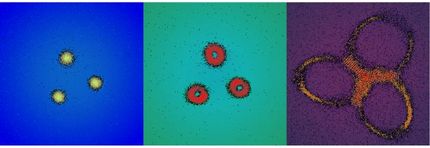Magnetic wormhole connecting 2 regions of space created for the first time
"Wormholes" are cosmic tunnels that can connect two distant regions of the universe, and have been popularised by the dissemination of theoretical physics. Using present-day technology it would be impossible to create a gravitational wormhole, as the field would have to be manipulated with huge amounts of gravitational energy, which no-one yet knows how to generate. In electromagnetism, however, advances in metamaterials and invisibility have allowed researchers to put forward several designs to achieve this.

(Left) 3-D diagram of the magnetic wormhole shows how the magnetic field lines (in red) leaves a magnet on the right pass through the wormhole. (Right) In terms of magnetism the wormhole is undetectable, which means that the magnetic field seems to disappear on the right only to reappear on the left in the form of a magnetic monopole.
Jordi Prat-Camps and Universitat Autònoma de Barcelona
Scientists in the Department of Physics at the Universitat Autònoma de Barcelona have designed and created in the laboratory the first experimental wormhole that can connect two regions of space magnetically. This consists of a tunnel that transfers the magnetic field from one point to the other while keeping it undetectable all the way.
The researchers used metamaterials and metasurfaces to build the tunnel experimentally, so that the magnetic field from a source, such as a magnet or a an electromagnet, appears at the other end of the wormhole as an isolated magnetic monopole. This result is strange enough in itself, as magnetic monopoles do not exist in nature. The overall effect is that of a magnetic field that appears to travel from one point to another through a dimension that lies outside the conventional three dimensions.
The wormhole in this experiment is a sphere made of different layers: an external layer with a ferromagnetic surface, a second inner layer, made of superconducting material, and a ferromagnetic sheet rolled into a cylinder that crosses the sphere from one end to the other. The sphere is made in such a way as to be magnetically undetectable - invisible, in magnetic field terms - from the exterior.
The magnetic wormhole is an analogy of gravitational ones, as it "changes the topology of space, as if the inner region has been magnetically erased from space", explains Àlvar Sánchez, the lead researcher.
This means a step forward towards possible applications in which magnetic fields are used: in medicine for example. This technology could, for example, increase patients' comfort by distancing them from the detectors when having MRI scans in hospital, or allow MRI images of different parts of the body to be obtained simultaneously.
Original publication
Most read news
Original publication
Organizations
Other news from the department science

Get the chemical industry in your inbox
By submitting this form you agree that LUMITOS AG will send you the newsletter(s) selected above by email. Your data will not be passed on to third parties. Your data will be stored and processed in accordance with our data protection regulations. LUMITOS may contact you by email for the purpose of advertising or market and opinion surveys. You can revoke your consent at any time without giving reasons to LUMITOS AG, Ernst-Augustin-Str. 2, 12489 Berlin, Germany or by e-mail at revoke@lumitos.com with effect for the future. In addition, each email contains a link to unsubscribe from the corresponding newsletter.


























































